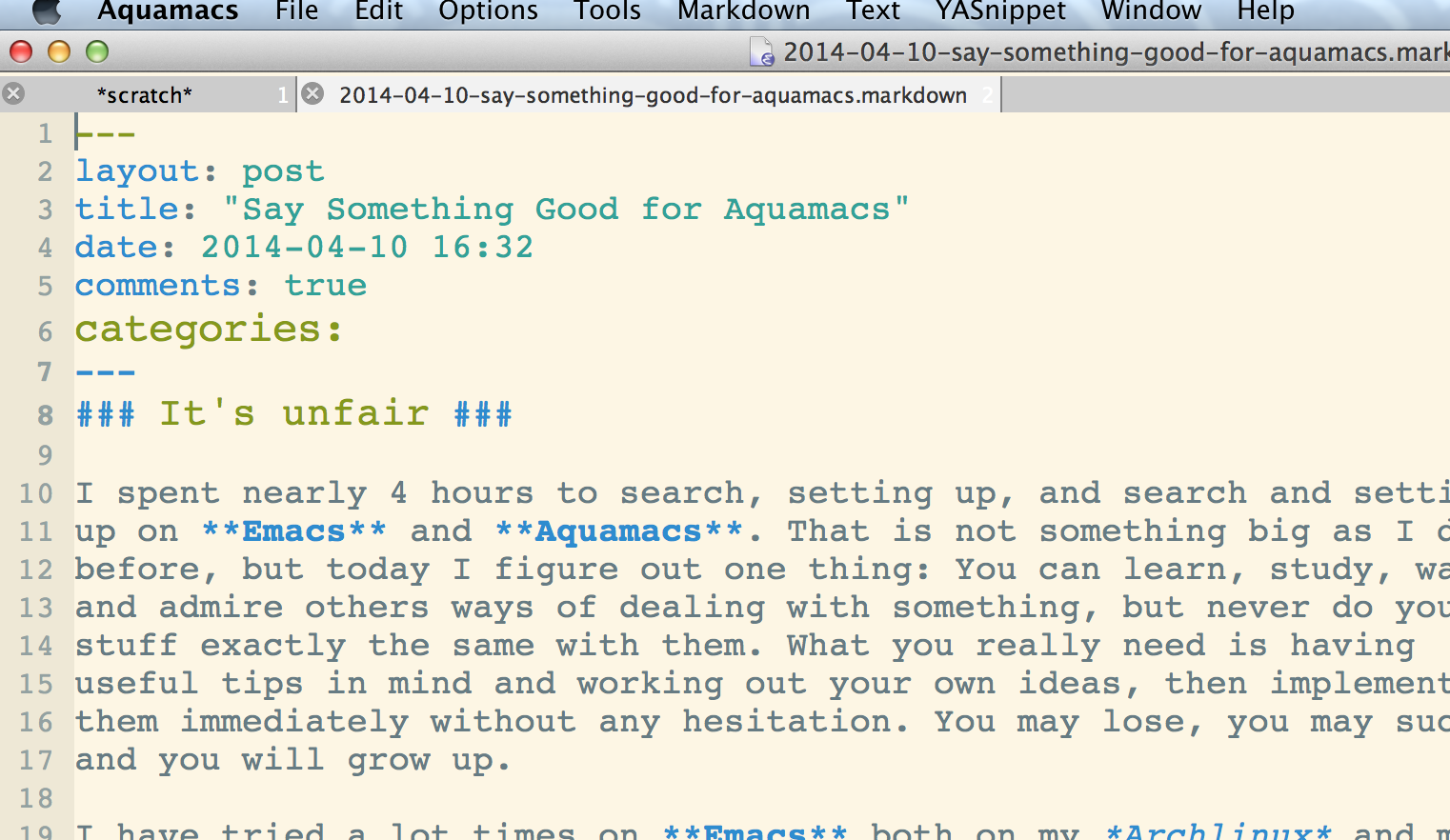Say Something Good for Aquamacs
It’s unfair

I spent nearly 4 hours to search, setting up, and search and setting
up on Emacs and Aquamacs. That is not something big as I did
before, but today I figure out one thing: You can learn, study, watch
and admire others ways of dealing with something, but never do your
stuff exactly the same with them. What you really need is having
useful tips in mind and working out your own ideas, then implement
them immediately without any hesitation. You may lose, you may succeed
and you will grow up.
I have tried a lot times on Emacs both on my Archlinux and my
Macbook, I even tried to get used to its org-mode to manage my
daily life, but I failed. It is really complex and annoying to setting
everything up to your habit or your perfect mind. After dealing with
the .emacs and .emacs.d files and folders together with many
plugins, I got a workable set of tools to handle various files (mostly
text files). But I always complain Emacs about the slow speed of
and screen flash on starting up, especially using its GUI model. So,
I learned about its daemon-mode, which works well under command line
environment. And, it also works excellent on my Archlinux +
Awesome PC. However, the annoying icons on the dock nearly drives me
crazy.
Then, I decide only use Emacs in my terminals (iTerm), and I use
MacVim and TextWrangler(hope I spelled it correctly) as my
GUI editor to deal with some document stuff. But it took no more
than one month before I found a lot of defectives of them and I always
hope I can write and read so smoothly in Emacs like on my
Archlinux PC. I struggled to give Aquamacs a try for nearly
three weeks, then I delete it for the reason that I encountered with
Sublime Text 2. I spent a whole night to setup Sublime Text 2.
After only one week, I found that ST 2 could almost handle all the
stuffs about GUI usage. I deleted MacVim and TextWrangler
immediately, and associate almost every text file with ST2.
Actually ST 2 is much more powerful than I thought not only on
Web Design solutions, but also on other text files and source codes
( I edit .py .txt .m .markdown by now, I will test others in
future). I also use ST 2 to build my Matlab source code, it’s
quick and nice looking for editing and exploring with good searching
and marking functions. ST 2 itself support auto-complete input,
but the snippets are not that rich, especially for markdown files,
which is my main document type for diary, blog and memos. Only
this reason drives me to go back and search for an elegant way to deal
with my markdowns.
Although I can edit them in terminal and my iTerm + Emacs
combination works well, whatever, I need a perfect editor as the main
writing tool. I think I tried enough on Emacs and it isn’t worth
any more efforts( or maybe someday I will start over ), so I decided
to start from Aquamacs, I think it is a high-level designed tool
base on Emacs.
This time the setting up did not cost me much time, because Emacs
is still in my system, and also the configuration files are all in the.emacs.d folder. I only need to add some GUI related settings to
Aquamacs, for example the windows size, the fonts and the color
themes. … and I almost forget the linenum-mode, I also fix the
annoying ugly line number when I zoom in or zoom out the text font
size. Many people told me that Aquamacs is only a hybrid tool
which is very weird and hard to use and worth nothing, you should use
original Emacs, and I once believed in that, but now I only want
to say: Go xxxk! OK, job’s done!
What???? The end???? This is your Say Something Good for
Aquamacs?? ARE YOU KIDDING ME??
Yes, you got it.
